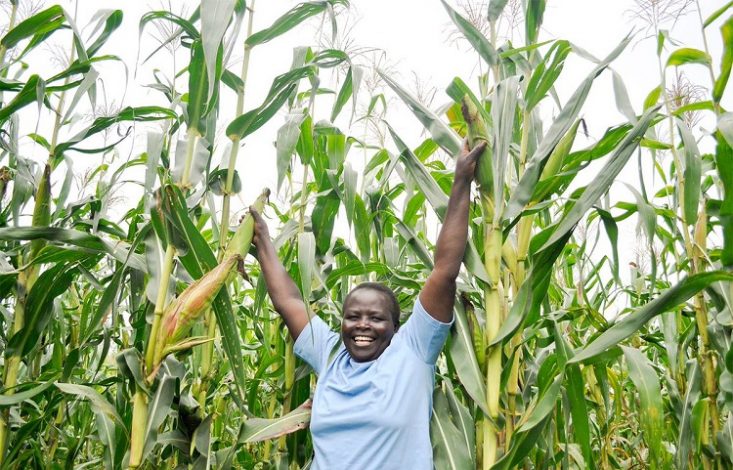Agriculture is the essence of life, but it seems leaders are not getting the idea as smallholder farmers continue to experience the effects of climate change and in their own innovative ways, are rapidly adapting.
Walk-in various farms of Western Kenya farmers, many reiterate that they have witnessed unpredictable weather conditions with long spells of drought and irregular rains that have had a negative effect on their lives.
Walk-in various farms of Western Kenya farmers, many reiterate that they have witnessed unpredictable weather conditions with long spells of drought and irregular rains that have had a negative effect on their lives.
“By May, our maize crops would have tussled after we had top-dressed but we are still planting or weeding for the first time. The planting season is over and we are not sure if we will have the yield we anticipate,” the farmers lament.
Christiana Figueres, Consultative Group on International Agricultural Research (CGIAR) Fund Council Chair and Vice President of Sustainable Development at the World Bank Inger Andersen, during the COP 16 meeting in Cancun, Mexico, noted that agriculture is an area that needs to be moved into the negotiations.
“The story about agriculture is one that is on everybody’s mind,” she said; “agriculture needs to be positive for people, positive for productivity, and positive for the climate.”
Improving agricultural productivity is the key to reducing poverty in the country. A global consensus has emerged that agriculture must move up on the global development agenda and that investment in agriculture, especially smallholder agriculture, must be increased if the twin goals of poverty reduction and food security are to be achieved.
In fact, if Kenya is to achieve the first Millennium Development Goal to eradicate extreme poverty and hunger, the agriculture sector needs to grow much faster and maintain an annual growth rate of 6.2 per cent.
This requires that we work on every single aspect of the agriculture production chain from regenerating depleted soil, using better seeds and more suitable fertilizers, whether organic or industrial, to drastically improving the quality of so-called extension services that support agriculture. It implies working on marketing and storage issues, road infrastructure, and financial services.
This requires that we work on every single aspect of the agriculture production chain from regenerating depleted soil, using better seeds and more suitable fertilizers, whether organic or industrial, to drastically improving the quality of so-called extension services that support agriculture. It implies working on marketing and storage issues, road infrastructure, and financial services.
Only by tackling all those aspects at once, involving both the public and private sectors, will we manage to improve agriculture productivity in a sustainable way.
One consequence of this neglect is the appalling state of rural infrastructure in Kenya. This leaves rural areas, which have the potential to feed the more than 40 million hungry people, cut off and isolated.
Kenya has only exploited a fraction of its irrigation potential, and the density of rural roads today is a fraction of what Asia had in the 1950s. As a result, farmers rely almost exclusively on rain-fed farming and face exceptionally high transport and marketing costs that make a shift to more efficient farming unprofitable.
Kenya has only exploited a fraction of its irrigation potential, and the density of rural roads today is a fraction of what Asia had in the 1950s. As a result, farmers rely almost exclusively on rain-fed farming and face exceptionally high transport and marketing costs that make a shift to more efficient farming unprofitable.
Kofi Annan (now deceased), Chairperson of the Board of the Alliance for a Green Revolution in Africa (AGRA), acknowledged this isolation:
“The average African small-holding farmer swims alone. She has no insurance against erratic weather patterns, gets no subsidies, and has no access to credit. I say ‘she’ because the majority of small-scale farmers in Africa are women.”
Access to farm inputs is critical in increasing farm productivity.
The current use of agricultural inputs and financial services is low amongst smallholder farmers in Kenya. Small-scale farmers in rural areas of Kenya have not been able to access financial services for acquiring farm inputs among other needs to improve farm productivity.
This is partly due to the low density of financial institutions in rural areas; inappropriate financial products; high cost and high risks of lending. Smallholder farmers adjust by resorting to informal credit, reduction of farm inputs, sub-optimal production techniques, and borrowing from family and friends.
This is partly due to the low density of financial institutions in rural areas; inappropriate financial products; high cost and high risks of lending. Smallholder farmers adjust by resorting to informal credit, reduction of farm inputs, sub-optimal production techniques, and borrowing from family and friends.
This limits the investment in farm equipment and capital as well as other agricultural assets and inputs. As a result, there is a need for practical assistance and capacity building to be provided by the private sector.
Secondly, financing rainwater harvesting projects through micro-credit organizations appear to be a sustainable delivery vehicle to enable communities to address the challenges of access to water and sanitation.
In addition, small-scale farmers concentrate on low-risk, low-return activities because they cannot access start-up capital and cannot transfer system risks. As a result, there is low agricultural productivity among smallholder farmers.
Low productivity attributed to the inadequate use of productivity-enhancing technologies and inputs such as fertilizers has led to food insecurity amongst smallholder households and worsened unemployment and poverty.
Credit is an important input into the production system and it contributes to increased food productivity. Access to credit increases the farmer’s working capital.
That would mean reversing the decline in the level of public resources spent on agriculture and rural development and investing more in agriculture.
Low productivity attributed to the inadequate use of productivity-enhancing technologies and inputs such as fertilizers has led to food insecurity amongst smallholder households and worsened unemployment and poverty.
Credit is an important input into the production system and it contributes to increased food productivity. Access to credit increases the farmer’s working capital.
That would mean reversing the decline in the level of public resources spent on agriculture and rural development and investing more in agriculture.
Khusoko is now on Telegram. Click here to join our channel and stay updated with the latest Agriculture and Environment news and updates.





2 Comments
Pingback: How Do We Ensure Food Security in Kenya?
Pingback: Confident Decision Making Key To Agriculture Productivity For Western Kenya